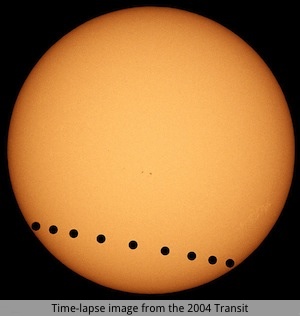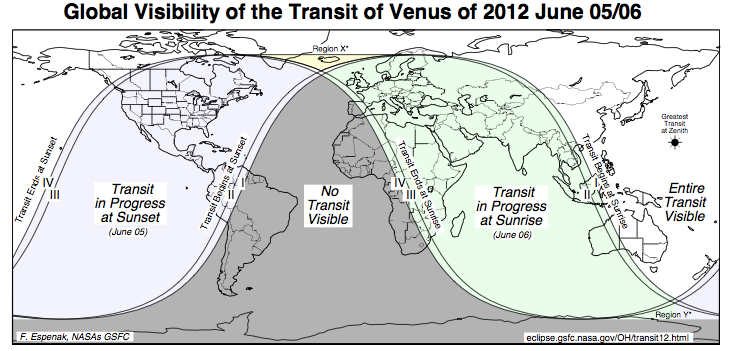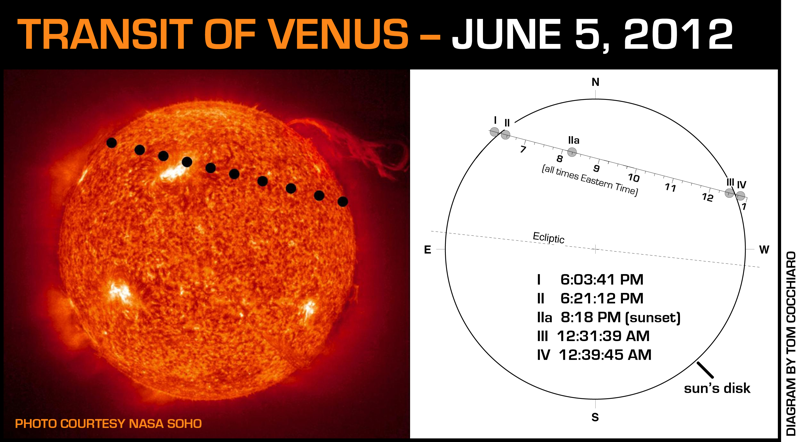 Transit of Venus
Transit of Venus
On the 5th of June, 2012, the planet Venus will pass directly between the Earth and the Sun. A portion of the event will be visible here in New England -- the Sun sets before the transit ends.
Transits of Venus are rare events and due to the orbital geometry of the Earth and Venus, they occur on a very specific schedule: There are always two transits separated by eight years, then either 105½ or 121½ years before the next pair. This transit is the second in the set, paired with the transit on June 8th, 2004. It is unlikely anyone alive today will witness the next transit of Venus in 2117. In fact, since the invention of the telescope in 1610, there have only been seven transits of Venus.
Viewing the TransitThe New Hampshire Astronomical Society will be set up in several locations around the state to provide free public viewing of the transit through specially filtered telescopes. The transit begins just after 6 PM EDT and runs through sunset, at about 8:15 PM. We will be set up at most locations by 5 PM, and may offer early evening stargazing after the transit, depending on weather. Weather will also be a factor in determining locations, so decisions are usually made a few days prior but possibly as late as the day of the event. Keep checking back!
In addition to the locations listed below, NHAS will be presenting a free talk on the transit at the Portsmouth Public Library, 175 Parrott Avenue, Portsmouth, NH from noon to 1PM. The library will also present live online viewing of the event starting at 6PM, even if the weather is good.
5 Jun 5:30 PM: Weather is looking bad throughout the region! Please refer to the "Poor Weather Plans" below.
| Stratham Hill Park, 270 Portsmouth Avenue, Stratham, NH | ||
View Larger Map |
Location - We will be set up in the park area on the walkway which leads from the parking lot to the pavilion, past the baseball field. Park in the Route 33 main parking lot and you will immediately see where the scopes are set up. Don't go to the back overflow lot on Jackrabbit Lane - it is too far away from where we will be. If weather permits there may be early evening viewing after the transit. | Poor Weather Plan - If this location is cloudy, but Hooksett is clear, we will relocate to that site (see below). If the entire region is clouded out, there will be a presentation and live online viewing of the transit at the Portsmouth Public Library, 175 Parrott Avenue, Portsmouth, NH starting at 5PM. Go to the Levenson Community Room on the 1st floor. |
| Hooksett Public Library, 31 Mount Saint Mary's Way, Hooksett, NH | ||
View Larger Map |
Location - We will be set up on the upper walkway on the west side of the building. If weather permits there will be early evening viewing after the transit. | Poor Weather Plan - If it is cloudy, there will be a presentation and live online viewing of the transit inside the library starting at 5PM. |
| General Sullivan Bridge, Newington, NH | ||
View Larger Map |
Location - This is a secondary location and may not have as many NHAS staff or scopes available for viewing. Parking will be at Newick's Lobster House, 431 Dover Point Road Dover, NH, then walk out onto the bridge which is closed to vehicles. | Poor Weather Plan - If this location is cloudy, but Hooksett is clear, we will relocate to that site (see above). If the entire region is clouded out, there will be a presentation and live online viewing of the transit at the Portsmouth Public Library, 175 Parrott Avenue, Portsmouth, NH starting at 5PM. Go to the Levenson Community Room on the 1st floor. |
| Westin Hotel, 70 3rd Avenue, Waltham, MA | ||
View Larger Map |
Location - Top of the parking garage (4th floor). This is a secondary location and may not have as many NHAS staff or scopes available for viewing. | Poor Weather Plan - Please visit one of the sites listed above for indoor viewing. |
Telescopes and binoculars should NEVER be pointed in the direction of the Sun! Permanent eye damage, and even blindness, is the inevitable result from even a fraction of a second's view of the Sun through an unfiltered astronomical instrument. A #14 or darker welding glass or mylar & cardboard solar viewing glasses can be used for naked-eye viewing of the Sun, but are not safe for use with telescopes or binoculars. These instruments, which are designed especially to gather and concentrate light, are not safe unless specifically designed for solar viewing or equipped with purpose-built astronomical solar filters. All NHAS viewing locations will provide safe views through these types of instruments. Don't risk your eyesight by trying a do-it-yourself substitute!


